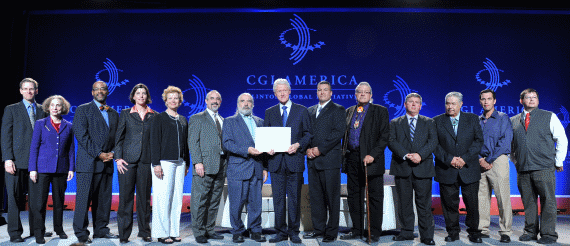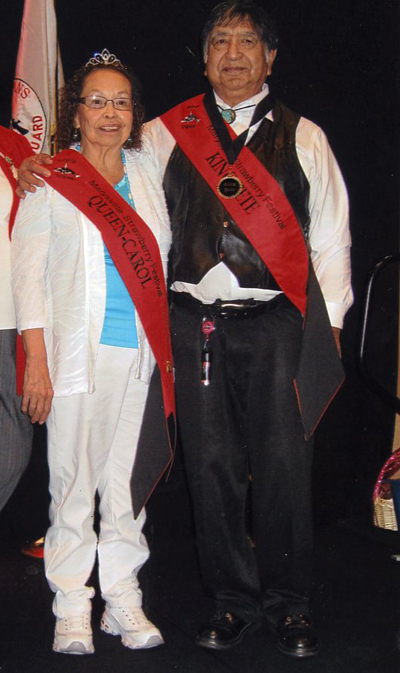
This artist rendering shows a proposed “Seaport City” neighborhood to be built just south of the Brooklyn Bridge that could act as a buffer against flooding in lower Manhattan.
Climate talk shifts from curbing CO2 to adapting to a new normal
Seth Borenstein, Associated Press
WASHINGTON — Efforts to curb global warming have quietly shifted as greenhouse gases inexorably rise.
The conversation is no longer solely about how to save the planet by cutting carbon emissions. It’s becoming more about how to save ourselves from the warming planet’s wild weather.
It was Mayor Michael Bloomberg’s announcement last week of an ambitious plan to stave off New York City’s rising seas with flood gates, levees and more that brought this transition into full focus.
After years of losing the fight against rising global emissions of heat-trapping gases, governments around the world are emphasizing what a U.N. Foundation scientific report calls “managing the unavoidable.”
It’s called adaptation and it’s about as sexy but as necessary as insurance, experts say.
It’s also a message that once was taboo among climate activists such as former Vice President Al Gore.
In his 1992 book “Earth in the Balance,” Gore compared talk of adapting to climate change to laziness that would distract from necessary efforts.
But in his 2013 book “The Future,” Gore writes bluntly: “I was wrong.” He talks about how coping with rising seas and temperatures is just as important as trying to prevent global warming by cutting emissions.
Like Gore, governmental officials across the globe aren’t saying everyone should just give up on efforts to reduce pollution. They’re saying that as they work on curbing carbon, they also have to deal with a reality that’s already here.
In March, President Barack Obama’s science advisers sent him a list of recommendations on climate change. No. 1 on the list: “Focus on national preparedness for climate change.”
“Whether you believe climate change is real or not is beside the point,” New York’s Bloomberg said in announcing his $20 billion adaptation plans. “The bottom line is: We can’t run the risk.”
On Monday, more than three dozen other municipal officials from across the country will go public with a nationwide effort to make their cities more resilient to natural disasters and the effects of man-made global warming.
“It’s an insurance policy, which is investing in the future,” Mayor Kevin Johnson of Sacramento, Calif., who is chairing the mayors’ efforts, said in an interview Friday. “This is public safety. It’s the long-term hazards that could impact a community.”
Discussions about global warming are happening more often in mayors’ offices than in Congress. The Obama administration and local governments are coming up with thousands of eye-glazing pages of climate change adaptation plans and talking about zoning, elevation, water system infrastructure, and most of all, risk.
“They can sit up there and not make any policies or changes, but we know we have to,” Broward County, Fla., Mayor Kristin Jacobs said. “We know that we’re going to be that first line of defense.”
University of Michigan professor Rosina Bierbaum is a presidential science adviser who headed the adaptation section of the administration’s new National Climate Assessment. “It’s quite striking how much is going on at the municipal level,” Bierbaum said. “Communities have to operate in real time. Everybody is struggling with a climate that is no longer the climate of the past.”
Still, Bierbaum said, “Many of the other developed countries have gone way ahead of us in preparing for climate change. In many ways, the U.S. may be playing catch-up.”
Hurricanes, smaller storms and floods have been a harsh teacher for South Florida, said Jacobs.
“Each time you get walloped, you stop and scratch your head … and learn from it and make change,” she said. “It helps if you’ve been walloped once or twice. I think it’s easier to take action when everybody sees” the effect of climate change and are willing to talk about being prepared.
What Bloomberg announced for New York is reasonable for a wealthy city with lots of people and lots of expensive property and infrastructure to protect, said S. Jeffress Williams, a University of Hawaii geophysicist who used to be the expert on sea level rise for the U.S. Geological Survey. But for other coasts in the United States and especially elsewhere in the poorer world, he said, “it’s not so easy to adapt.”
Rich nations have pledged, but not yet provided, $100 billion a year to help poor nations adapt to global warming and cut their emissions. But the $20 billion cost for New York City’s efforts shows the money won’t go far in helping poorer cities adapt, said Brandon Wu of the nonprofit ActionAid.
At U.N. climate talks in Germany this past week, Ronald Jumeau, a delegate from the Seychelles, said developing countries have noted the more than $50 billion in relief that U.S. states in the Northeast got for Superstorm Sandy.
That’s a large amount “for one storm in three states. At the same time, the Philippines was hit by its 15th storm in the same year,” Jumeau said. “It puts things in context.”
For poorer cities in the U.S., what makes sense is to buy out property owners, relocate homes and businesses and convert vulnerable sea shores to parks so that when storms hit “it’s not a big deal,” Williams said. “I think we’ll see more and more communities make that decision largely because of the cost involved in trying to adapt to what’s coming.”
Jacobs, the mayor from South Florida, says that either people will move “or they will rehab their homes so that they can have a higher elevation. Already, in the Keys, you see houses that are up on stilts. So is that where we’re going? At some point, we’re going to have to start looking at real changes.”
It’s not just rising seas.
Sacramento has to deal with devastating droughts as well as the threat of flooding. It has a levee system so delicate that only New Orleans has it worse, said Johnson, the California capital’s mayor.
The temperature in Sacramento was 110 this past week. After previous heat waves, cities such as Chicago, Philadelphia and Washington, D.C., have come up with cooling centers and green roofs that reduce the urban heat island affect.
Jacobs said cities from Miami to Virginia Beach, Va., are coping with mundane efforts: changes in zoning and building codes, raising the elevation of roads and runways, moving and hardening infrastructure. None of it grabs headlines, but “the sexiness is … in the results,” she said.
For decades, scientists referenced average temperatures when they talked about global warming. Only recently have they focused intensely on extreme and costly weather, encouraged by the insurance industry which has suffered high losses, Bierbaum said.
In 2012, weather disasters — not necessarily all tied to climate change — caused $110 billion in damage to the United States, which was the second highest total since 1980, the National Oceanic and Atmospheric Administration said last week.
Now officials are merging efforts by emergency managers to prepare for natural disasters with those of officials focused on climate change. That greatly lessens the political debate about human-caused global warming, said University of Colorado science and disaster policy professor Roger Pielke Jr.
It also makes the issue more local than national or international.
“If you keep the discussion focused on impacts … I think it’s pretty easy to get people from all political persuasions,” said Pielke, who often has clashed with environmentalists over global warming. “It’s insurance. The good news is that we know insurance is going to pay off again.”
Describing these measures as resiliency and changing the way people talk about it make it more palatable than calling it climate change, said Hadi Dowlatabadi, a University of British Columbia climate scientist.
“It’s called a no-regrets strategy,” Dowlatabadi said. “It’s all branding.”
All that, experts say, is essentially taking some of the heat out of the global warming debate.
Online:
Federal government’s National Climate Assessment chapter on adaptation.
The national mayors’ efforts to promote adaptation.
Georgetown University’s Climate Center primer on adaptation.


















